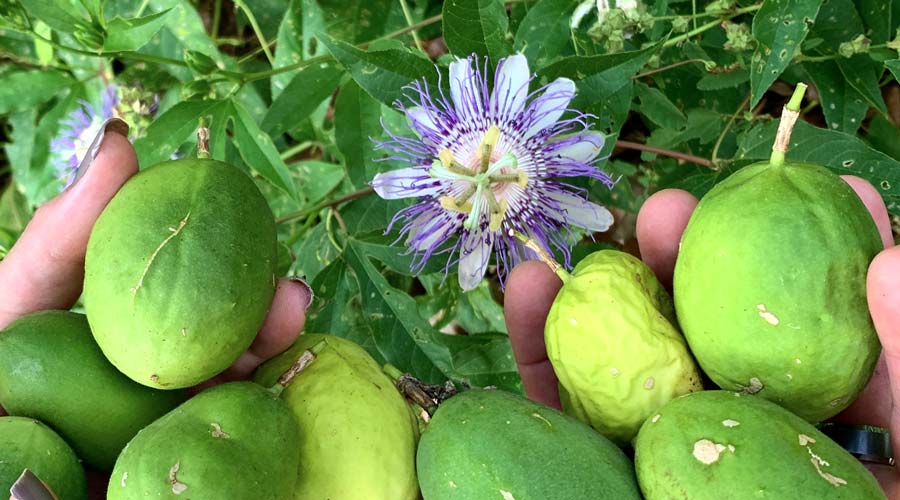Reeds Spring, MO. Last fall, newly arrived in our home, my wife and I discovered wild maypops growing in our yard. Also known as purple passion flower, these native vines feature spectacular flowers, a Christological botanical name (Passiflora incarnata), and—we read as we identified the plants online—delicious edible fruits. To successfully bear and ripen fruit in our climate, however, the vines need something to climb. Lacking that, the maypops by our house straggled across the ground and produced nothing edible, or at least nothing worth eating. A few fruits grew yellow and wrinkled and appeared ripe, but they offered no flavor besides a puckering acidity. We were disappointed, but not surprised, given our lack of experience with the plant.
This spring, however, we erected a haphazard trellis using prunings from our crape myrtle bushes and awaited our maypop harvest. Shortly, we had robust vines which fruited heavily; however, we still had little idea how to tell when the fruit would ripen. We waited. Though we neither planted nor watered these wild, weedy vines, we nonetheless cherished a fervent desire for a harvest.
Somehow, when that harvest came, it still surprised me. In late September, I was doing the merest garden puttering, just inspecting the maypop crop, thinking a harvest might still be a month off. As I knelt beside the trellis, however, a heady aroma struck me, sweet and floral with a hint of pineapple. As I inspected the fruit, one dropped into my hand of its own accord. I tore it open; the pulp inside, though seedy, tasted like a perfectly ripe mango, with distinct notes of banana and citrus. It was among the most delicious fruits I have ever eaten.
It is difficult to convey the intensity and delight of this experience without sounding like the merest glutton. The truth is, I was moved by my first maypop; I did not merely relish its flavor, but rather, I rejoiced in it, almost to the point of tears.
All a bit much, I agree. I share this experience, at the risk of sounding more than a little histrionic, because it puzzles me: I responded immediately to the maypop with a strength of feeling that I still find somewhat embarrassing. What was it about the maypop that elicited such a response?
For one thing, for a person of localist commitment, a native plant with the flavors of a tropical fruit could scarcely be a more valuable discovery. The maypop gives the lie to the idea that we need industrialized, global food markets to have a rich and varied diet. Today, even in the coldest parts of North America, tropical fruits like bananas and oranges are staple foods, readily available even at convenience stores. Such a situation represents both a triumph of human ingenuity and the deep distortions of our industrial culture, for as wonderful as it can be to have access to such foods, their constant presence in climates where they cannot grow is unsustainable, consuming far too much in transport and storage, not to mention the damage inflicted on their tropical sites of origin by monocultural growing practices.
Yet the aspiring localist can find it difficult to replace familiar staples of the industrial era with their local equivalents, as Aaron Thier writes in an old essay for the late, lamented Lucky Peach: despite his recognition that his properly local breakfast staple in Florida would be fried green bananas, he laments, “Oatmeal and bread are, to me, deep down, food.” So, for many of us even in cold climates, are tropical fruits, accustomed as we are to the affordances of the industrial diet.
The maypop shows, however, that localism need not mean confining oneself to an austere and moralistic diet. If I cannot grow bananas and mangoes in the Ozarks, I can nonetheless harvest maypops. I can plant fruits that boast a cornucopia of tropical flavors: native pawpaws and persimmons, or hardy exotics like jujubes and the vividly named “zombiefruit.” With a little creativity and attention to plants forgotten by our industrial systems, we can eat locally without sacrificing the pleasures of tropical flavors.
That dietary function alone would be enough to make the maypop valuable, yet the fruit offers a further grace. I have previously written for FPR about planting where I might not reap a harvest—in the maypop, now, I have the opportunity to reap where I did not sow. As such, the maypop was a manifestation of common grace: another way I enter through creation into the gift cycle of planting and harvesting. My maypops sprang up without my intervention, and I enjoy them freely; likewise, I plant trees and vines that should bear after I am gone from this place.
The casual way we Westerners talk about karma likely bears no real resemblance to the authentic Hindu concept, so please indulge me if I take aim at it for a moment. Our notion of karma is crudely, even violently, reciprocal: do good that it might be rendered, in equal measure, back unto you. Do ut des, as the ancient Latin formula has it for sacrifices to the Greco-Roman pantheon: give that you might receive. The is double-entry accounting, a cosmic tit for tat.
Thankfully, the Christian doctrine of grace is both more mysterious and more generous than Western ersatz karma. God’s grace is a free gift, one that enables reciprocation but does not demand it and certainly involves no balancing of a spiritual checkbook. Moreover, common grace is a gift given to all, circulating endlessly, present in the very fact of our continued existence. Planting a tree has more in common with this doctrine than with karma, for there is no obvious return on investment, no guarantee that the apple tree I plant today will be repaid unto me with peaches elsewhere. Instead, by planting a tree I can participate in God’s common grace, creating the kind of small good thing that I myself benefit from every day.
Such common-grace benefits are not limited to the relatively trivial gift of fruit, wonderful as it is. Far from it: the maypops I pick testify that I did not make my place. Its ecology and all the good things it offers, beginning with the soil itself, are the products of graces offered long before I came here, by divine providence and the work of human and nonhuman beings. Such graces exceed by far my poor ability to understand, never mind my capability to reciprocate.
Picking tropical fruit grown in my own backyard is indeed a great gift. The possibility that anything can grow at all is the greater; yet greatest of all is the prospect that I too participate in furthering that possibility, that common grace. Maybe Passiflora incarnata moved me to an embarrassing degree that September day because I intuited, however dimly, my place and the maypop’s in that circle of gifts.






5 comments
Russell Arben Fox
Matt, a friend of mine was made curious by your piece, and he contacted a horticulturalist who knows something about maypops–Dr. Eric Stafne at Mississippi State University. This is what he learned and shared with me (it came as short FB messages, some I’m collating). According to Dr. Stafne:
Why hasn’t the maypop been domesticated? Several reasons:
Because they’re not self-pollinating, so you need multiple male and female vines. And its flowersattract only particular bee species, mostly carpenter bees and bumblebees. They don’t pollinate with honeybees.
Because they often have an odd, funky taste that many people don’t like. This is less bad when they’re fully ripe and the sugar content is at its maximum, but that gives you a small window for harvesting them, maybe just a day or two. And the fruits ripen a couple at a time over a period of weeks. That’s not a problem for casual gardening, but a huge minus for commercial agriculture.
Because maypops don’t control well. The upper part dies off in autumn, but underground they can spread far and fast. Again, fine in a casual garden, but not in commercial agriculture; if they do get loose, they’re a weedy species that, if the environment is friendly, will aggressively crowd out other plants.
Finally, because they need to be trellised, and then in autumn you need to clear away the dead leaves and stems. These things, plus the drawn-out ripening, makes the maypop a very labor intensive fruit to cultivate.
Nutritionally, a ripe maypop is tasty but in terms of fruits per acre or calories per acre, it’s not very productive. Like most wild plants, it puts a lot of energy into the hull and the large seeds, and not enough (insofar as human consumption is concerned) into the edible sweet pulpy aril.
In theory you could breed a maypop with larger fruit, smaller seeds, that is less “weedy” and inclined to spread, and that ripens all its fruit at once instead of sequentially. Plant breeders have done stranger and more extreme things than this! But nobody’s trying to do this right now.
So, all in all, if you can grow maypops in your garden, go for it! But for now, it’s not going to be a major part of any solution to most of our food problems.
Anyway (Russell here again), I found that interesting information. Perhaps you already knew all that, but I thought it worth sharing here.
Matt Miller
Very interesting—there’s much there I didn’t know, so thank you for sharing.
I would note that the maypops not ripening all at once isn’t just inconsequential for the home grower, but a positive advantage—it’s harder to handle large volumes of fruit at once in a home context.
Andrew Gonzalez
Thanks for your article, Matt. Have you read C.S. Lewis’s “Perelandra”? Your story reminded me of Chapter 3, when Dr. Ranson discovers the planet’s ambrosial fruit.
When I was a boy, my best friend taught me about one wild fruit found here in Virginia. They’re called wineberries (Rubus phoenicolasius), and despite being considered an invasive by some (the fruit is native to Asia), the stems provide buckets of delicious, raspberry-like fruit every summer. I always start looking for its festive color around the fourth of July. It’s a beautiful and humbling thing to enjoy fruit that Nature cultivates on her own.
Matt Miller
Thank you, Russell! I find the maypop really fun to grow, but do keep in mind that the plant spreads readily over about a 10-foot area, so I would only plant it in a spot where you don’t mind some extra shoots popping up. I find it to be absolutely worth a little weediness. I know you can get seed stock from at least two places: Oikos Tree Crops in Michigan and Mountain Gardens in North Carolina.
Russell Arben Fox
What a lovely little essay, about a fruit I’d never heard of before, but now feel myself inspired by, as I make plans to up my own Wichita, KS, garden’s potential (both nutritionally and sustainably speaking) this spring. Thank you!
Comments are closed.